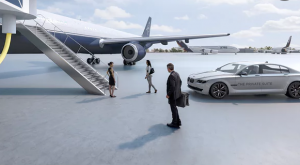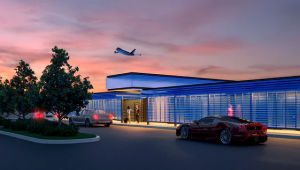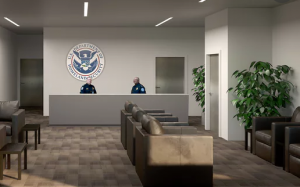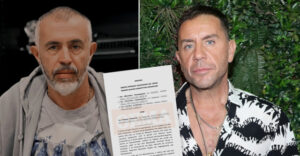The guiltiest pleasure at Los Angeles international airport’s (LAX) new private terminal for the mega-rich is not the plush, hushed privacy, or the beds with comforters, or the massages, or the coriander-scented soap, or the Willie Wonka-style array of chocolates and jelly beans, or the Napa Valley cabernet.
It is the iPad that sits on a counter at the entrance, with a typed little note: “Here is a glimpse of what you’re missing over at the main terminal right now.”
The screen shows travellers hauling bags through packed terminals, queuing in long lines, looking harassed and being swallowed into pushing, shoving paparazzi scrums – routine hazards for the 80 million people who pass through LAX each year.
“There they process thousands of people at a time, they’re barking. It’s loud. Here it’s very, very lovely,” said Gavin de Becker, who runs the new terminal, called Private Suite.
He wasn’t wrong. The $22m facility, the first of its kind in the US, opens on Monday, giving the 1% a whole new way to separate themselves from everyone else’s reality.
Luxury, de Becker said while giving the Guardian a tour, is secondary to convenience – to escaping the hassle of modern air travel. “The real purpose here is logistics.” He reckons about a tenth of his clients will be celebrities who are fed up with the paparazzi staking out LAX. The rest will be corporate – CEOs and other members of capitalism’s top brass.
De Becker, who runs a security consulting firm, borrowed the concept from Heathrow’s Windsor Suite, a marbled sanctuary for popes, presidents and other VIPs tucked in a corner of Terminal 5.
Instead of battling the traffic jams that clog LAX you reach Private Suite via the Imperial Highway, leading to a discreet turn-off where an armed guard checks your identity and pushes a button. Tall grey gates open and you enter the haven.
It is pricey. In addition to annual membership of $7,500, you pay $2,700 per domestic flight and $3,000 per international flight. The cost covers a group of up to four people. If you aren’t a member, you pay $3,500 for a domestic flight and $4,000 for international flight for a group of up to three people.
There are 13 suites, each with bathrooms, televisions, drinks, organic snacks, wifi, gadgets and views of planes trundling across runways. There are menus of toys for children and prayer mats for Muslims.
If you spill some cabernet, no worries: pick up the phone and within minutes a man in a blazer will wheel in a cart with Calvin Klein socks, Banana Republic dress shirts, Anne Klein blouses and Steve Madden shoes. If the weather at your destination looks a bit damp help yourself to a water-resistant jacket.
If in need of some Hunger Games-style schadenfreude check out the iPad showing the hoi polloi running gauntlets over at the main terminal.
Another man in a blazer will check in your luggage and let you know when it is time to leave your suite and enter the “gallery”, a mini-terminal disguised as a hotel lounge. It is decorated with rotating art installations – currently it is a series of humming bird portraits by the photographer Gary Yost – which you can buy, with proceeds going to charity.
When it is time to leave a TSA agent from the main terminal will pop over to screen you and any companions. A BMW will then whisk you to your plane. Arrivals receive the same treatment, with leather armchairs and platters of chocolates flanking the customs and immigration desk.
De Becker rebuffed any suggestion that his terminal symbolised inequality.
It cost taxpayers nothing and would generate $34m for LAX over the next nine years, he said. Plus it would make his clients likelier to use commercial flights rather than charter private jets. “It’s all about the airport, about predictability. When you charter you can buy your way out of the line.”
So Private Suite was an egalitarian advance? De Becker nodded. “It’s a voluntary tax on the wealthy.”
America’s most famous socialist, he suggested, would approve. “I love Bernie Sanders.”
Ask me anything
Explore related questions








